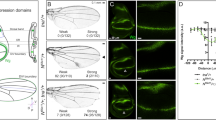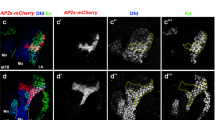Abstract
HOMEODOMAIN proteins regulate diverse developmental processes in a wide range of organisms, yet bind in vitro to DNA sequences that are remarkably similar1. This has raised the fundamental question of how target gene specificity is achieved in vivo. The Drosophila fushi tarazu protein (Ftz) contains a homeodomain2 and is required for the formation of alternate segments3. We have shown previously that a homeodomain-deleted Ftz polypeptide (FtzΔHD), incapable of binding DNA in vitro, could regulate endogenous ftz gene expression4. Here we test FtzΔHD activities in a ftzmutant background and find that, surprisingly, FtzΔHD can directly regulated ftz-dependent segmentation, suggesting that it can control target gene expression through interactions with other proteins. A likely candidate is the pair-rule protein Paired (Prd). FtzΔHD bound directly to Prd in vitro and required Prd to repress wingless in vivo. These results emphasize the pivotal importance of protein–protein interactions in homeodomain protein function.
This is a preview of subscription content, access via your institution
Access options
Subscribe to this journal
Receive 51 print issues and online access
$199.00 per year
only $3.90 per issue
Buy this article
- Purchase on Springer Link
- Instant access to full article PDF
Prices may be subject to local taxes which are calculated during checkout
Similar content being viewed by others
References
Hayashi, S. & Scott, M. P. Cell 63, 883–894 (1990).
Shepherd, J. C. W. et al. Nature 310, 70–71 (1984).
Wakimoto, B. T. & Kaufman, T. C. Devl Biol. 81, 51–64 (1981).
Fitzpatrick, V. D. et al. Nature 356, 610–612 (1992).
Furukubo-Tokunaga, K. et al. Genes Dev. 6, 1082–1096 (1992).
Schier, A. F. & Gehring, W. P. Nature 356, 804–807 (1992).
DiNardo, S. & O'Farrell, P. H. Genes Dev. 1, 1212–1225 (1987).
Ingham, P. W., Baker, N. E. & Martinez-Arias, A. A. Nature 331, 73–75 (1988).
Struhl, G. Nature 318, 677–680 (1985).
Ish-Horowicz, D. et al. Cell 57, 223–232 (1989).
Kilcherr, F. et al. Nature 321, 493–499 (1986).
Li, X., Gutjahr, T. & Noll, M. EMBO J. 12, 1427–1436 (1993).
Li, X. & Noll, M. EMBO J. 12, 4499–4509 (1993).
Frigerio, G. et al. Cell 47, 735–746 (1986).
Bopp, D. et al. Cell 47, 1033–1049 (1986).
Treisman, J. et al. Genes Dev. 5, 594–604 (1991).
Baumgartner, S. & Noll, M. Mech. Dev. 33, 1–18 (1991).
Ananthan, J. et al. Molec. cell. Biol. 13, 1599–1609 (1993).
Driever, W., Thoma, G. & Nüsslein-Volhard, C. Nature 340, 363–367 (1989).
Manoukian, A. & Krause, H. M. Genes Dev. 6, 1740–1751 (1992).
Krause, H. M., Klemenz, R. & Gehring, W. J. Genes Dev. 2, 1021–1036 (1988).
Gallagher, S. et al. in Current Protocols in Molecular Biology (eds Ausubel, F. A. et al.) 10.8.7–10.8.17 (Wiley, New York, 1993).
Author information
Authors and Affiliations
Rights and permissions
About this article
Cite this article
Copeland, J., Nasiadka, A., Dietrich, B. et al. Patterning of the Drosophila embryo by a homeodomain-deleted Ftz polypeptide. Nature 379, 162–165 (1996). https://doi.org/10.1038/379162a0
Received:
Accepted:
Issue Date:
DOI: https://doi.org/10.1038/379162a0
This article is cited by
-
Hox genes, evo-devo, and the case of the ftz gene
Chromosoma (2016)
-
A Ds-insertion mutant of OSH6 (Oryza sativa Homeobox 6) exhibits outgrowth of vestigial leaf-like structures, bracts, in rice
Planta (2007)
-
The nuclear receptor homologue Ftz-F1 and the homeodomain protein Ftz are mutually dependent cofactors
Nature (1997)
-
Mutation of HOXA13 in hand-foot-genital syndrome
Nature Genetics (1997)
-
The nuclear hormone receptor Ftz-F1 is a cofactor for the Drosophila homeodomain protein Ftz
Nature (1997)
Comments
By submitting a comment you agree to abide by our Terms and Community Guidelines. If you find something abusive or that does not comply with our terms or guidelines please flag it as inappropriate.



